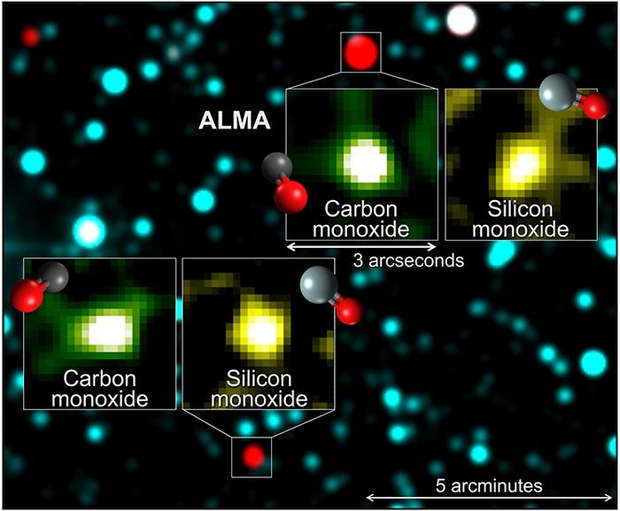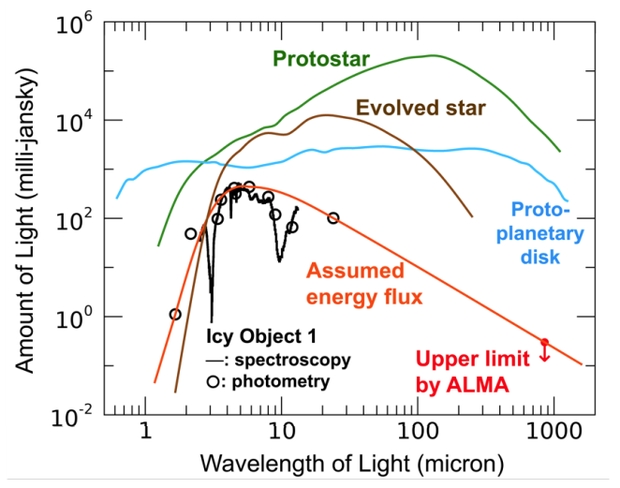Peculiar things always get our attention, calling to mind the adage that scientific discovery revolves around the person who notices something no one else has and says “That’s odd.” The thought is usually ascribed to Asimov, but there is evidently no solid attribution. Whoever said it in whatever context, “that’s odd” is a better term than “Eureka!” to describe a new insight into nature. So often we learn not all at once but by nudges and hunches.
This may be the case with the odd objects turned up by the Japanese infrared satellite AKARI in 2021. Looking toward the Scutum-Centaurus Arm along the galactic plane, the observatory found deep absorption bands of the kind produced by interstellar dust and ice. No surprise that a spectral analysis revealed water, carbon dioxide, carbon monoxide and organic molecules, given that interstellar ices in star-forming regions are rich in these chemicals, but the ‘odd’ bit is that these two objects are a long way from any such regions.

Image: Molecular emission lines from mysterious icy objects captured by the ALMA telescope. The background image is an infrared composite color map, where 1.2-micron light is shown in cyan and 4.5-micron light is in red, based on infrared data from 2MASS and WISE. Credit: ALMA (ESO/NAOJ/NRAO), T. Shimonishi et al. (Niigata Univ).
Interstellar ices are produced as submicron-sized dust grains, rich in carbon, oxygen, silicon, magnesium and iron, gather materials that adhere to their surfaces in cold and dense regions of the galaxy. Such ices are thought to be efficient at producing complex organic molecules, more so than chemical reactions that form in gaseous states, so they’re of high astrobiological interest.
The team performed follow-up observations using ALMA (this is the Atacama Large Millimeter/submillimeter Array in Chile) at a wavelength of 0.9 mm, useful because radio, as opposed to infrared, can be used to analyze the motion and composition of such gases. The data showed that what is being observed doesn’t exhibit the characteristics of any previously known interstellar objects in the vicinity of such ices. Instead, the researchers found molecular emission lines of carbon monoxide and silicon monoxide distributed in a tight region of less than one arcsecond. The expected submillimeter thermal emission from interstellar dust was not detected.
So what’s going on here? Takashi Shimonishi, an astronomer at Niigata University, Japan and lead author of the paper on this work, notes that the two objects are roughly 30,000 to 40,000 light years away. Interestingly, they show different velocities, indicating that they’re distinct and moving independently. Says the scientist:
“This was an unexpected result, as these peculiar objects are separated by only about 3 arcminutes on the celestial sphere and exhibit similar colors, brightness, and interstellar ice features, but they are not linked [to] each other.”
Let’s take a closer look at the odd energy distribution here. We would expect objects surrounded by ices would be embedded in interstellar dust, which should make for a bright signal in the far-infrared to submillimeter wavelength range. But ALMA detected no submillimeter radiation from either object. No previously known icy objects correspond to this signature.

Image: Energy distribution of one of the mysterious icy objects (black) compared with those of known interstellar icy objects. Interstellar ices are detected in protostars (green), young stars with protoplanetary disks (cyan), and mass-losing evolved stars (brown), but the spectral characteristics of the mysterious icy object do not match any of these known sources. Credit: T. Shimonishi et al. (Niigata Univ).
We learn from the paper that strong shockwaves seem to have disrupted interstellar dust in these bodies, based on the ratio of silicon monoxide to carbon monoxide. And the final oddity, at least so far: The size of the gas and dust clouds associated with these objects – determined by comparison of ALMA emission data with the AKARI absorption data – shows that both range from 100 to 1000 AU, which makes them compact in relation to typical molecular clouds.
So we have objects that don’t correspond to stars in the early stages of formation or stars shielded by dense molecular clouds. We seem to be looking at a new class of interstellar object altogether. The paper concludes:
These characteristics, i.e., (i) rich ice-absorption features, (ii) large visual extinction, (iii) lack of mid-infrared and submillimeter excess emission, (iv) very compact source size, (v) SiO-dominated broad molecular line emission [silicon monoxide], and (vi) isolation, cannot easily be accounted for by any of known interstellar icy sources. They may represent a previously unknown or rare type of isolated icy objects. Future high-spatial-resolution and high-sensitivity observations as well as detailed SED modeling is required. An upcoming near-infrared spectroscopic survey with SPHEREx (M. L. N. Ashby et al. 2023) may detect more similar sources.
Let’s hope so, because insight into oddities is a key part of interstellar exploration. Clearly we haven’t heard the last of these mysterious bodies.
The paper is Takashi Shimonishi et al., “ALMA Observations of Peculiar Embedded Icy Objects,” Astrophysical Journal 981 (2025), 49 (full text).



Interesting! Any anomalous object could be a technosignature, of course, but we’ll need to get the objects better characterized before we draw any conclusions.
As far as the science quote goes, I definitely associate it with Asimov – if only because he has a character say it in Fantastic Voyage 2.
Well, sort of. This is the quote from that book:
“For a moment, Konev and Morrison stared at each other hostilely and then Dezhnev said in a voice that seemed drained of some of its life, “My poor old father used to say: ‘The most frightening phrase in the Russian language is “That’s odd.”’”
Konev turned angrily and said, “Shut up, Arkady.”
Dezhnev replied, “I mentioned that only because it is now time for me to say it: That’s odd.”
There’s an interesting discussion of the question of Asimov’s attribution at:
https://quoteinvestigator.com/2015/03/02/eureka-funny/
I’ve often wondered what Hubble muttered to himself when he finally realized that studies of Cepheid variables in Andromeda proved M31 was not just an object in our Milky Way, but a distant external galaxy in its own right.
Hubble was a fortunate man. It happened twice in his lifetime. He must have said the same thing when he finally plotted the luminosity-redshift curve of distant galaxies and realized that not only they were other galaxies, but that the universe was expanding.
Henry, I read that although Hubble discovered it, he didn’t believe that it was actual expansion. He believed that it was something that looked like expansion, but was really something else.
These objects are extremely close together in angular separation but thousands of parsecs apart along the line-of sight. This implies that they are either representatives of a very common type of object (many more will be discovered shortly), or they were created in the same physical event, an event that somehow placed them in an almost perfectly straight line with Earth. Check the map of their galactic locations in the linked ApJ article. Very strange.
Keep an eye open for follow-up on these guys. I suspect they are very important.
Nothing is telling us these objects are common?
Surely if that was the case, many would’ve been found before now, and much closer to us also.
Or is it the case that they are undetectable by other means, even if close by?
If I had been Hubble, I wouldn’t have believed in an expanding universe either! But the red shift data still meant that something very peculiar was going on.
The fact that if you connect these two objects, (located nowhere near each other across the galaxy) with a straight line, that line points directly to earth. There are only two explanations, either earth was somehow connected to the formation of these two objects, or they are merely the first-discovered two of many such objects scattered across the Milky Way.
My intuition favors the latter, these objects are common in the galaxy, and if you look at any one of them it is not unexpected to see another in the field, as a background or foreground object.
Perhaps the fact that these two have just been simultaneously discovered is a coincidence made possible by the use of this new observing technique.
Both of these objects are highly separated in space, but are very close together in RA and Dec, and a line connecting the two points directly at earth.
SPHEREx is expected to discover more of these objects as it covers the 0.75 to 5 micron wavelength range. This includes the study of the origin of water and other pre-biotic molecules in planetary systems.
The Origin of Water – and Other Pre-biotic Molecules – in Planetary Systems.
https://spherex.caltech.edu/page/the-origin-of-water-in-planetary-systems
https://spherex.caltech.edu/download/MediaFile/42/binary/original
Hopefully it launches on the 8th of March.
Is there any reason why they could not match these sources with optical telescopes to determine whether ther is a stellar object at the core or not? It seems to me that the anomaly is a low luminosity accompanies by a Bolzmann curve indicative of a source hotter than a forming star. Is this because there is a source, but the cloud is more compact? Could it be a very cool star or a brown dwarf?
These are (cold) gas clouds, not “objects” as in planets, comets or asteroids.
Perhaps a CO white dwarf has interacted or is interacting with a large terrestrial object.
March 20, 2025
Concept for interstellar object encounters developed, then simulated using a spacecraft swarm
by University of Illinois at Urbana-Champaign
https://phys.org/news/2025-03-concept-interstellar-encounters-simulated-spacecraft.html
Interstellar objects are among the last unexplored classes of solar system objects, holding tantalizing information about primitive materials from exoplanetary star systems. They pass through our solar system only once in their lifetime at speeds of tens of kilometers per second, making them elusive.
Hiroyasu Tsukamoto, a faculty member in the Department of Aerospace Engineering in the Grainger College of Engineering, University of Illinois Urbana-Champaign, has developed Neural-Rendezvous—a deep-learning-driven guidance and control framework to autonomously encounter these extremely fast-moving objects.
The research is published in the Journal of Guidance, Control, and Dynamics and on the arXiv preprint server.
“A human brain has many capabilities: talking, writing, etcetera,” Tsukamoto said. “Deep learning creates a brain specialized for one of these capabilities with domain-specific knowledge. In this case, Neural-Rendezvous learns all the information it needs to encounter an ISO, while also considering the safety-critical, high-cost nature of space exploration.”
The paper here:
https://arxiv.org/abs/2411.09110